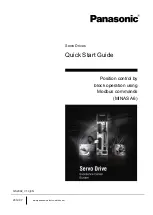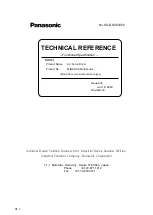
Version 2.00
| Optidrive ODE-3 User Guide |
25
www.invertekdrives.com
Par.
Description
Minimum Maximum
Default
Units
P-25
Analog Output Function Select
0
11
8
-
Digital Output Mode. Logic 1 = +24V DC
0: Drive Enabled (Running).
Logic 1 when the Optidrive is enabled (Running).
1: Drive Healthy.
Logic 1 When no Fault condition exists on the drive.
2: At Target Frequency (Speed).
Logic 1 when the output frequency matches the setpoint frequency.
3: Drive Tripped.
Logic 1 when the drive is in a fault condition.
4: Output Frequency >= Limit.
Logic 1 when the output frequency exceeds the adjustable limit set in P-19.
5: Output Current >= Limit.
Logic 1 when the motor current exceeds the adjustable limit set in P-19.
6: Output Frequency < Limit.
Logic 1 when the output frequency is below the adjustable limit set in P-19.
7: Output Current < Limit.
Logic 1 when the motor current is below the adjustable limit set in P-19.
Analog Output Mode
8: Output Frequency (Motor Speed).
0 to P-01, resolution 0.1Hz.
9: Output (Motor) Current.
0 to 200% of P-08, resolution 0.1A.
10: Output Power.
0 – 200% of drive rated power.
11: Load Current.
0 – 200% of P-08, resolution 0.1A.
P-26
Skip frequency hysteresis band
0.0
P-01
0.0
Hz / RPM
P-27
Skip Frequency Centre Point
0.0
P-01
0.0
Hz / RPM
The Skip Frequency function is used to avoid the Optidrive operating at a certain output frequency, for example at a frequency
which causes mechanical resonance in a particular machine. Parameter P-27 defines the centre point of the skip frequency band,
and is used in conjunction with P-26. The Optidrive output frequency will ramp through the defined band at the rates set in P-03 and
P-04 respectively, and will not hold any output frequency within the defined band. If the frequency reference applied to the drive is
within the band, the Optidrive output frequency will remain at the upper or lower limit of the band.
P-28
V/F Characteristic Adjustment Voltage
0
P-07
0
V
P-29
V/F Characteristic Adjustment Voltage
0.0
P-09
0.0
Hz
This parameter in conjunction with P-28 sets a frequency point at which the voltage set in P-29 is applied to the motor. Care must be
taken to avoid overheating and damaging the motor when using this feature.
P-30
Start Mode, Automatic Restart, Fire Mode Operation
Index 1: Start Mode & Automatic Restart
N/A
N/A
Edge-r
-
Selects whether the drive should start automatically if the enable input is present and latched during power on. Also configures the
Automatic Restart function.
: Following Power on or reset, the drive will not start if Digital Input 1 remains closed. The Input must be closed after a
power on or reset to start the drive.
: Following a Power On or Reset, the drive will automatically start if Digital Input 1 is closed.
To
: Following a trip, the drive will make up to 5 attempts to restart at 20 second intervals. The
numbers of restart attempts are counted, and if the drive fails to start on the final attempt, the drive will trip with a fault, and will
require the user to manually reset the fault. The drive must be powered down to reset the counter.
Index 2: Fire Mode Input Logic
0
1
0
-
Defines the operating logic when a setting of P-15 is used which includes Fire Mode, e.g. settings 15, 16 & 17.
0: Normally Closed (NC) Input.
Fire Mode active if input is open.
1: Normally Open (NO) Input.
Fire Mode active if input is closed.
Index 3: Fire Mode Input Type
0
1
0
-
Defines the input type when a setting of P-15 is used which includes Fire Mode, e.g. settings 15, 16 & 17.
0: Maintained Input.
The drive will remain in Fire Mode, only as long the fire mode input signal remains
(Normally Open or Normally Closed operation is supported depending on Index 2 setting).
1: Momentary Input.
Fire Mode is activated by a momentary signal on the input. Normally Open or Normally Closed
operation is supported depending on Index 2 setting. The drive will remain in Fire Mode until disabled or powered off.
Parameters
6
















































